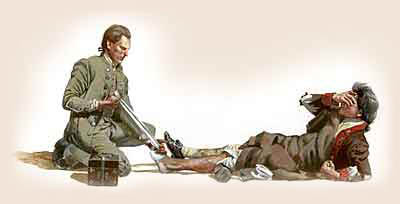|
|
|
 |
|
|
|
 |
|
|
 he cries of the wounded and dying who remained on the field of action during the night exceed all description. Such a complicated scene of horror and distress, it is hoped, for the sake of humanity, rarely occurs, even in a military life. he cries of the wounded and dying who remained on the field of action during the night exceed all description. Such a complicated scene of horror and distress, it is hoped, for the sake of humanity, rarely occurs, even in a military life.
 Charles Stedman Charles Stedman
|
|
|
|
 |
|
|
|
 ecords indicate that few of the practicing doctors in Colonial America had formal training. Many prescribed calomel, mercury and quinine. Some applied Native American herbal remedies. Bleeding, sweating, cupping and blistering, cold baths, and laxative use were common treatments. There were few, if any, dentists. Soldiers injured on the battlefield had little chance of recovery. The Battle of Guilford Courthouse proved to be particularly deadly ecords indicate that few of the practicing doctors in Colonial America had formal training. Many prescribed calomel, mercury and quinine. Some applied Native American herbal remedies. Bleeding, sweating, cupping and blistering, cold baths, and laxative use were common treatments. There were few, if any, dentists. Soldiers injured on the battlefield had little chance of recovery. The Battle of Guilford Courthouse proved to be particularly deadly
 he aftermath of all battles was dreadful. However, the battle of Guilford Courthouse was particularly bad. Dead and dying lay over a thousand acres of ground. Shortly after the last shots were fired, torrential rain fell. The rain complicated locating and caring for the wounded. Doctors and medicines were in short supply. With the help of neighboring Quakers and others, the British cared for both sides. A British surgeon amputated arms and legs, extracted lead balls, and set broken bones. Guilford Courthouse and houses within an eight-mile radius were used as hospitals. Many wounded died from infections and blood poisoning. A smallpox epidemic claimed more lives after the battle. he aftermath of all battles was dreadful. However, the battle of Guilford Courthouse was particularly bad. Dead and dying lay over a thousand acres of ground. Shortly after the last shots were fired, torrential rain fell. The rain complicated locating and caring for the wounded. Doctors and medicines were in short supply. With the help of neighboring Quakers and others, the British cared for both sides. A British surgeon amputated arms and legs, extracted lead balls, and set broken bones. Guilford Courthouse and houses within an eight-mile radius were used as hospitals. Many wounded died from infections and blood poisoning. A smallpox epidemic claimed more lives after the battle.
|
|
|
 |
 |
 |
|
 |
 |
 |
|
 |
|
|
|
 |
|
|
|
Click an image to enlarge |
|
|
|
 |
|
|
|
 never did and I hope that I never shall experience two such days and nights as those immediately after the battle. We remained on the very ground on which it had been fought, covered with dead, with dying and with hundreds of wounded, rebels as well as our own. A violent and constant rain that lasted above forty hours made it equally impracticable to remove or administer the smallest comfort to our wounded. never did and I hope that I never shall experience two such days and nights as those immediately after the battle. We remained on the very ground on which it had been fought, covered with dead, with dying and with hundreds of wounded, rebels as well as our own. A violent and constant rain that lasted above forty hours made it equally impracticable to remove or administer the smallest comfort to our wounded.
 General Charles O'Hara General Charles O'Hara
 British, Crown Forces British, Crown Forces |
|
|
|
 |
|
|
|
|
|
|
|
|
|
|
|
|
|
|
|
|
|
|

